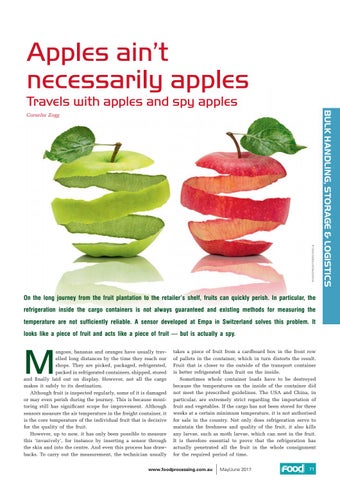Apples ain’t necessarily apples Travels with apples and spy apples
© Stock.Adobe.com/au/jefunne
On the long journey from the fruit plantation to the retailer’s shelf, fruits can quickly perish. In particular, the refrigeration inside the cargo containers is not always guaranteed and existing methods for measuring the temperature are not sufficiently reliable. A sensor developed at Empa in Switzerland solves this problem. It looks like a piece of fruit and acts like a piece of fruit — but is actually a spy.
M
angoes, bananas and oranges have usually travelled long distances by the time they reach our shops. They are picked, packaged, refrigerated, packed in refrigerated containers, shipped, stored and finally laid out on display. However, not all the cargo makes it safely to its destination. Although fruit is inspected regularly, some of it is damaged or may even perish during the journey. This is because monitoring still has significant scope for improvement. Although sensors measure the air temperature in the freight container, it is the core temperature of the individual fruit that is decisive for the quality of the fruit. However, up to now, it has only been possible to measure this ‘invasively’, for instance by inserting a sensor through the skin and into the centre. And even this process has drawbacks. To carry out the measurement, the technician usually
takes a piece of fruit from a cardboard box in the front row of pallets in the container, which in turn distorts the result. Fruit that is closer to the outside of the transport container is better refrigerated than fruit on the inside. Sometimes whole container loads have to be destroyed because the temperatures on the inside of the container did not meet the prescribed guidelines. The USA and China, in particular, are extremely strict regarding the importation of fruit and vegetables. If the cargo has not been stored for three weeks at a certain minimum temperature, it is not authorised for sale in the country. Not only does refrigeration serve to maintain the freshness and quality of the fruit, it also kills any larvae, such as moth larvae, which can nest in the fruit. It is therefore essential to prove that the refrigeration has actually penetrated all the fruit in the whole consignment for the required period of time.
www.foodprocessing.com.au
May/June 2017
71
BULK HANDLING, STORAGE & LOGISTICS
Cornelia Zogg
